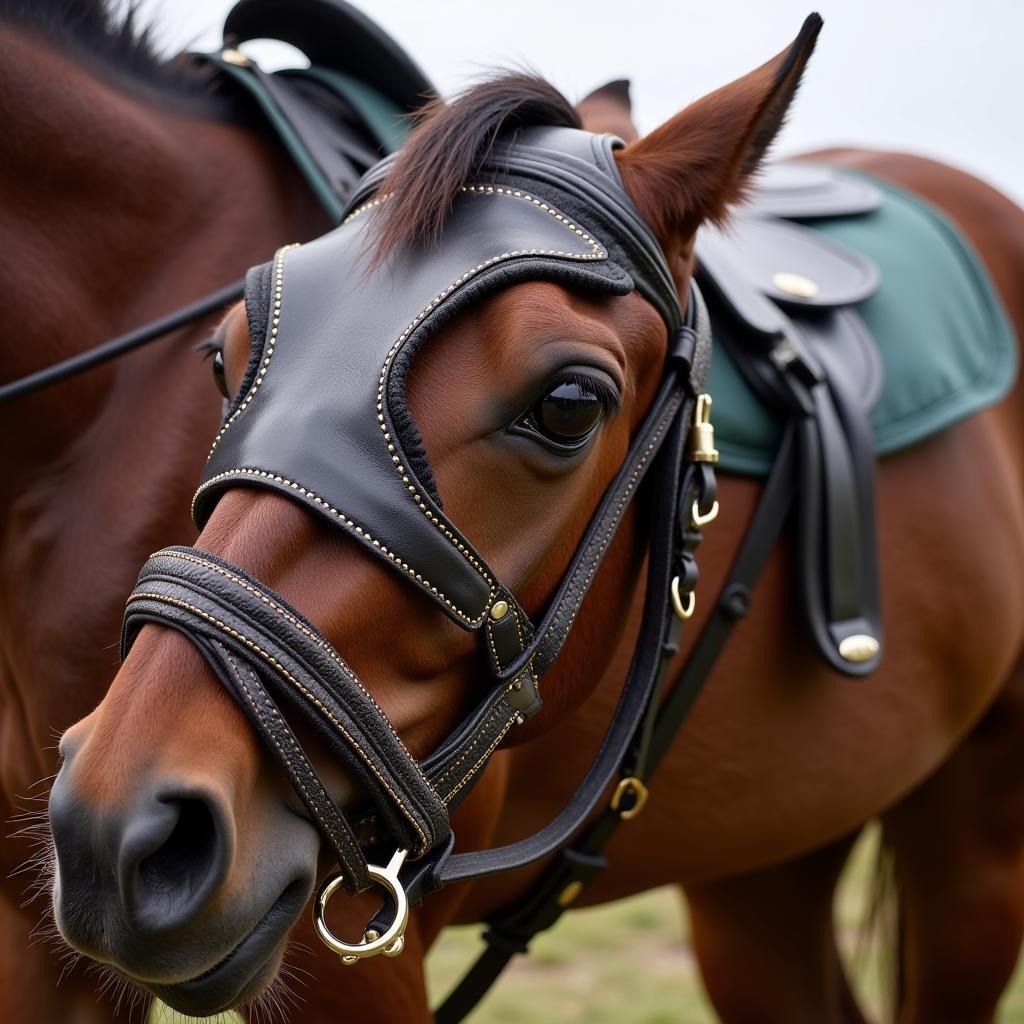Race Horse Tack plays a crucial role in a horse’s performance and safety. From saddles and bridles designed for speed to protective gear that minimizes risk, understanding the essentials of race horse tack is paramount for any owner, trainer, or racing enthusiast. This guide will delve into the key components of effective and ethical race horse tack, providing you with the knowledge to equip your equine athlete for success.
Understanding the Core Components of Race Horse Tack
Race day demands specialized equipment, each piece designed to enhance speed and control while prioritizing the horse’s well-being. The basic components include the saddle, bridle, and reins, all of which must be lightweight, durable, and fitted precisely. Beyond these fundamentals, other essential tack includes bits, girths, and breastplates, each playing a specific role in optimizing performance. Choosing the right tack can be the difference between a win and a loss, impacting both speed and the horse’s comfort. Are you interested in horse-themed clothing?
Just as a finely tuned instrument needs the right accessories, race horses require specific tack to perform optimally. The saddle, for instance, must be lightweight to avoid hindering the horse’s stride, yet secure enough to provide a stable platform for the jockey. Similarly, the bridle and reins are crucial for communication and control, enabling the jockey to guide the horse effectively. Understanding the function and importance of each piece of tack is vital for responsible horse ownership and successful racing. You can find other interesting information related to horses at our horse racing Boise Idaho page.
 Race Horse Tack: Saddle and Bridle Fitted on a Thoroughbred
Race Horse Tack: Saddle and Bridle Fitted on a Thoroughbred
Choosing the Right Bit: A Key to Communication and Control
The bit plays a pivotal role in communication between horse and jockey. While numerous bit designs exist, racing typically employs specific types designed for subtle cues and rapid responses. Snaffle bits and D-ring snaffles are common choices, their design promoting responsiveness without excessive pressure. Selecting the right bit depends on the horse’s individual temperament and sensitivity, making expert advice invaluable. Ill-fitting or inappropriate bits can cause discomfort and negatively impact performance. Do you need a horse neon sign?
Proper bit selection requires careful consideration of the horse’s mouth conformation and riding style. A bit that is too harsh can cause pain and resistance, while a bit that is too mild might not provide sufficient control. Working with a knowledgeable equine professional can ensure that the bit is appropriately fitted and adjusted, optimizing communication and preventing discomfort. Check out information about a horse-drawn funeral carriage on our website.
Protective Gear: Prioritizing Safety on the Track
Beyond performance-enhancing equipment, protective gear is essential for safeguarding the horse’s well-being. Bell boots shield the heels from overreaching, preventing injury during the intense strides of a race. Splint boots offer support and protection to the delicate tendons in the lower leg, minimizing the risk of strains or sprains. These seemingly small additions to a horse’s tack can make a significant difference in preventing injuries and promoting long-term soundness.
Imagine running at full speed – now imagine doing so with the weight of a jockey on your back. Protective gear is crucial in mitigating the risks inherent in this demanding sport. By providing support and protection to vulnerable areas, these pieces of equipment help prevent injuries and ensure that racehorses can compete safely. If you’re a crossword enthusiast, our website offers a fun course for a horse crossword puzzle.
Conclusion: Equipping Your Racehorse for Success
Investing in high-quality, properly fitted race horse tack is an investment in your horse’s performance, comfort, and safety. From the essential saddle and bridle to the nuanced selection of a bit and the protective benefits of bell boots and splint boots, each element of race horse tack plays a crucial role. By understanding the function and importance of each piece, you can equip your equine athlete for peak performance and contribute to a safe and ethical racing experience.
FAQs
-
What is the most important piece of race horse tack? The saddle and bridle are arguably the most fundamental pieces, ensuring rider stability and control.
-
How often should race horse tack be inspected? Tack should be thoroughly inspected before and after each use to identify any wear or damage.
-
What is the purpose of a racing bit? The bit is crucial for communication, allowing the jockey to guide and control the horse.
-
Why are bell boots important for racehorses? Bell boots protect the heels from overreaching, preventing injuries during a race.
-
What are splint boots used for? Splint boots support and protect the tendons in the lower leg, minimizing the risk of strains.
-
How can I ensure my horse’s tack fits correctly? Consulting a professional tack fitter is essential for ensuring proper fit and maximizing comfort and performance.
-
What materials are commonly used in race horse tack? Leather is the most traditional material, valued for its durability and flexibility. Synthetic materials are also becoming increasingly popular.
For any questions or support, contact us at Phone: 0772127271, Email: [email protected], or visit us at QGM2+WX2, Vị Trung, Vị Thuỷ, Hậu Giang, Vietnam. Our customer service team is available 24/7.